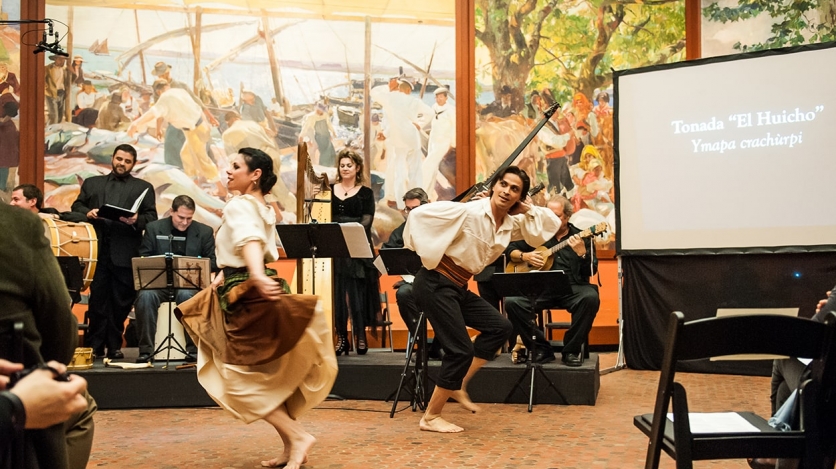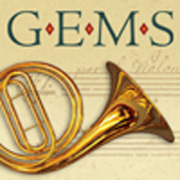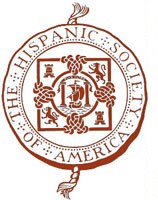8:00 p.m.
Share

The Bishop's Band at The Hispanic Society. (Image: Roey Yohai Studios)
Codex II: The Bishop's Band
This concert features a performance of early music led by Tom Zajac, featuring soprano Nell Snaidas.
Overview
For ticketholders: Hispanic Society's visitor entrance is located on Audubon Terrace at Broadway between 155th and 156th Streets. Click here for visitor information.
Admission Fee: FREE for Americas Society and Hispanic Society of America Members; $25 for non-members.
Not yet a member? JOIN NOW!
Americas Society and GEMS present the second concert dedicated to Martínez Compañón’s book, music of late 18th-century Peru from the Codex Trujillo del Perú, performed by the Bishop's Band. Directed by multi-instrumentalist and early music specialist Tom Zajac and featuring soprano Nell Snaidas along with an all-star cast of singers, instrumentalists, and dancers, the Band will perform a selection of the songs and dances in the collection.
Now held in the Royal Library in Madrid, the source of these songs and dances is a nine-volume collection of watercolor paintings mostly of flora and fauna that was presented to King Charles IV of Spain in the late 1780s by then Bishop of Trujillo, Baltasar Jaime Martínez Compañón. The collection is the end result of a 32-month visita, or official journey that the bishop undertook through the grasslands, deserts, mountains, rainforests, and coastal plains surrounding Trujillo in his efforts to get to know the people, the geography, and the resources of these regions. Volume II of the collection is devoted to portraits of people of all social strata, and includes paintings of dancers in colorful costumes and instrumentalists playing European violins, guitars, harps, bandolas, pipes, and tabors, as well as a number of indigenous and African wind and percussion instruments. Adjacent to these vibrant images are the scores of twenty pieces of music probably heard by the bishop’s company during their travels, written in a very elegant classical-era hand. Each piece has a title that gives the form and a description (e.g. Tonada El Diamante – Tonada of the diamond), information about whether it is to be sung, or danced or both, and often the name of the town where it was collected. The subject matter of the vocal pieces varies greatly; there are love songs, a sailors' song, a song of penitence in a near extinct native language, a song in the voice of an African slave decrying his condition, and a devotional song to the Virgin Mary. Just as the paintings depict local customs, these musical works are transcriptions of what was heard by the bishop's company in their travels and thus give a wonderful and rare snapshot of the traditions of late eighteenth-century colonial music making.
The collection is best described as an early ethnomusicological gathering of local songs and dances. Certainly, one could imagine, if the bishop was on his visita in the early twentieth century, he would likely have had a cylinder or disk recorder with him to document the music, just as Bela Bartok did in his explorations of the Balkans, or John and Alan Lomax did on their journeys in the southern United States. This concert offers an incredibly rare opportunity to hear, frozen in the amber of the 1780s, a moment in the development of a regional music, as it makes its way from the raw ingredients of European, African, and indigenous styles, to the true melding or creolization that is now thought of as Andean or Peruvian music.
The program also contains three sets of Bolivian music; the first, sacred villancicos from the Cathedral of La Plata, in what is now the modern city of Sucre; a set of three charming songs in the Canichanas Indian language from the Bolivian rain forest; and a diverse selection of instrumental and vocal pieces of a more popular nature from a collection called the Moxos archives from another Jesuit mission further to the north from the Canichanas region.The melodies are memorable, the harmonies are catchy, and the rhythms are lively and syncopated, announcing present-day Latin American popular music.
The concert will take place in the Hispanic Society’s beautiful Sorolla y Bastida Mural Gallery and will be accompanied by slide projections of the codex illustrations and subtitles of the translations of the texts, providing the listener with a wonderfully intimate and immediate experience. Carlos Fittante, Robin Gilbert Campos, Bárbara Martínez, and Ricardo Santiago—who specialize in historical performance and flamenco, respectively—will perform dances inspired by the paintings.
SINGERS
Nell Snaidas - tiple primero
Jennifer Ellis-Kampani - tiple segundo
Daniela Tošić - alto
Jason McStoots - tenor
Paul Guttry - bajo
STRINGS
Robert Mealy – violín primero
Holly Piccoli – violín segundo
Michael Unterman – cello
BASSO CONTINUO AND RHYTHM SECTION
Grant Herreid - guitar, theorbo
Scott Pauley - guitar, theorbo
Paul Shipper - guitar, percussion
Paula Fagerberg - Spanish cross-strung harp
Danny Mallon - percussion
Tom Zajac - percussion and winds
DANCERS
Bárbara Martínez
Ricardo Santiago
Carlos Fittante
Robin Gilbert Campos
This is the second of two performances inspired by the music of the Trujillo del Perú manuscript to be presented in April by Americas Society. The first concert, Codex I, will take place on April 7 at 4:00 pm and will feature the premieres of four pieces commissioned by Americas Society from internationally known composers for members of the International Contemporary Ensemble. For further information on this concert please click here.
This concert is part of GEMAS, a project of Americas Society and Gotham Early Music Scene devoted to early music of the Americas with Nell Snaidas and Sebastián Zubieta as co-artistic directors.
Event Information: Kris Simmons | ksimmons@as-coa.org | 1-212-277-8379
Membership Information: Valeria Catan | vcatan@as-coa.org | 1-212-277-8342
Press Inquiries: Adriana La Rotta | alarotta@as-coa.org | 1-212-277-8384









